Notes:
In 1961 BR (WR) announced the total re-building of the station with platforms at street level, new refreshment facilities, a modern ticket office and car parking above the station with a shopping arcade situated above the car park. Before any of the WR’s ambitious plans could be realised there was on boundary reorganisation within BR and from 1 January 1963 Snow Hill station came under the control of the London Midland Region (LMR). On 15 May 1964 the first passenger service withdrawal on a route emanating from Snow Hill was witnessed with the final service to Dudley via Swan Village. Seasonal extras still ran through to Dudley to serve the castle 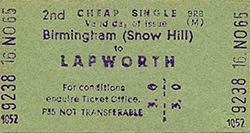 and zoo until August. By the mid 1960s the LMR installed a connection with the former Midland Railway (MR) at St Andrews Junction allowing trains from Paddington to reach Birmingham New Street for the first time. Electrification of the New Street to Euston line was completed in early 1967 and a full electric service was inaugurated in March of that year. The LMR subsequently announced that Snow Hill would be closing to main line traffic from 4 March 1967 with all services to be concentrated on the New Street site; a reduction in the frequency of services to Paddington was to take place on the same day. So, from Monday 6 March 1967, only 74 trains would commence or end their journeys at Snow Hill compared to the former 181. To add to the reduction in workings through the station, from the same date all freight was diverted away from the station and 300 staff were also transferred to other positions within the LMR. A further blow for the station was seen on 2 March 1968 with the final local train departing, the 17.52 for Leamington Spa, through Snow Hill Tunnel and onto the North Warwickshire lines. All trains from the south were to terminate at Birmingham Moor Street from the 4 March. In May 1968 further rationalisation came with the closure of several of the stations along the northern part of the main line, and in August 1968 the main lines between Handsworth and Hockley were taken out of use with the remaining services moved to the relief lines. 5 May 1969 saw all stations from Snow Hill to Wolverhampton Low Level become unstaffed halts with the ‘Paytrain’ system implemented on which the train guard was expected to collect all fares. The single-car DMU, which plied between the two stations during the morning and evening rush hour, was surprisingly busy as the service was virtually unadvertised. Regular commuters gave themselves the nickname the ‘commuters club’. and zoo until August. By the mid 1960s the LMR installed a connection with the former Midland Railway (MR) at St Andrews Junction allowing trains from Paddington to reach Birmingham New Street for the first time. Electrification of the New Street to Euston line was completed in early 1967 and a full electric service was inaugurated in March of that year. The LMR subsequently announced that Snow Hill would be closing to main line traffic from 4 March 1967 with all services to be concentrated on the New Street site; a reduction in the frequency of services to Paddington was to take place on the same day. So, from Monday 6 March 1967, only 74 trains would commence or end their journeys at Snow Hill compared to the former 181. To add to the reduction in workings through the station, from the same date all freight was diverted away from the station and 300 staff were also transferred to other positions within the LMR. A further blow for the station was seen on 2 March 1968 with the final local train departing, the 17.52 for Leamington Spa, through Snow Hill Tunnel and onto the North Warwickshire lines. All trains from the south were to terminate at Birmingham Moor Street from the 4 March. In May 1968 further rationalisation came with the closure of several of the stations along the northern part of the main line, and in August 1968 the main lines between Handsworth and Hockley were taken out of use with the remaining services moved to the relief lines. 5 May 1969 saw all stations from Snow Hill to Wolverhampton Low Level become unstaffed halts with the ‘Paytrain’ system implemented on which the train guard was expected to collect all fares. The single-car DMU, which plied between the two stations during the morning and evening rush hour, was surprisingly busy as the service was virtually unadvertised. Regular commuters gave themselves the nickname the ‘commuters club’.
It is probably important, at this juncture, to look at the closure procedure and how final closure was achieved by BR (LMR). In 1966 the LMR issued a proposal to close the route north of Snow Hill, and all stations, in its entirety with trains on the North Warwickshire line terminating at Moor Street. In 1966 there were 24 trains in each direction to and from Wolverhampton, supplemented by 14 services to Stourbridge calling at Hockley with around 2,000 people per day travelling on these services. Objections were posted to the Transport Users Consultative Committee (TUCC) and the case for closure was discussed on 20 September 1966. The recommendation of the TUCC was that the line should remain open as closure would cause ‘extreme hardship’. This ruling caused the LMR to change tactics with the announcement that, as of 4 March 1967, the main line trains along the whole route would be withdrawn and freight trains diverted along other routes. On 15 November 1967 the Minister of Transport, Barbara Castle, responded to BR’s closure application refusing to allow the closure of the Wolverhampton to .jpg) Snow Hill and the branch to Langley Green but allowing the closure of the southern section from Snow Hill through to Moor Street. With this the four-track section between Handsworth and Hockley could no longer be justified, so in August 1968 it was announced that the main lines would be closed and all remaining traffic concentrated on the relief lines. The introduction of the May timetable in 1969 saw all intermediate stations between Wolverhampton Low Level and Birmingham Snow Hill become unstaffed halts, making Snow Hill the largest unstaffed halt in the world; Nottingham Victoria had briefly held this inglorious record in its final two months in 1967. Monday 4 March 1968 saw the withdrawal of services south of Snow Hill and the tunnel and lines through to Moor Street taken out of use; coupled with this the services from Stourbridge Junction were diverted into New Street, although a two-hourly shuttle was introduced between Snow Hill and Langley Green to connect with it. On the same day the service frequency was drastically reduced, this not requiring any permission from the TUCC or Snow Hill and the branch to Langley Green but allowing the closure of the southern section from Snow Hill through to Moor Street. With this the four-track section between Handsworth and Hockley could no longer be justified, so in August 1968 it was announced that the main lines would be closed and all remaining traffic concentrated on the relief lines. The introduction of the May timetable in 1969 saw all intermediate stations between Wolverhampton Low Level and Birmingham Snow Hill become unstaffed halts, making Snow Hill the largest unstaffed halt in the world; Nottingham Victoria had briefly held this inglorious record in its final two months in 1967. Monday 4 March 1968 saw the withdrawal of services south of Snow Hill and the tunnel and lines through to Moor Street taken out of use; coupled with this the services from Stourbridge Junction were diverted into New Street, although a two-hourly shuttle was introduced between Snow Hill and Langley Green to connect with it. On the same day the service frequency was drastically reduced, this not requiring any permission from the TUCC or 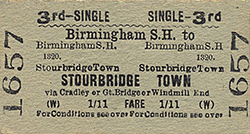 the Minister of Transport. The station now had just three morning and three evening services in each direction, with a lunchtime Saturday- only service to cater for shoppers on the route to Wolverhampton. This was supplemented by the Langley Green shuttle which had four down, Snow Hill to Langley Green, and 5 up services per day. By the end of 1970 the station had a very run-down atmosphere with vandalism prevalent, and passenger numbers had dwindled to less than a tenth of what they had been just four years previously. The newly-formed West Midlands Public Transport Authority (WMPTA) recognised the importance of the route although, as it did not become responsible for local rail services until 1972, it could not react to the next move that BR made. Closure notices were posted by BR on 31 March 1971 with the final date for objections to be received as 19 May 1971. The TUCC received 199 objections in total, and on 25 May they, along with representatives from BR and WMPTE (the Executive body of the WMPTA), inspected the route and all the stations travelling from Snow Hill by train to Wolverhampton; ironically they returned by bus! A Public Hearing was held at the Rainbow Suite in Birmingham on 14 July 1971 for objections to be voiced and for the fate of the line to be decided. One objection from D J Yew Tree of West Bromwich stated, ‘I use the train from West Bromwich to Snow Hill to get to work…… I shall suffer hardship because it will mean me having to get three buses, thus more than doubling my journey time each day’. Despite the best efforts of the TUCC and the folk who objected to the closure it was granted, by the Minister, on 24 January 1972 with BR (LMR) swiftly announcing that the final trains would run on 4 March 1972. the Minister of Transport. The station now had just three morning and three evening services in each direction, with a lunchtime Saturday- only service to cater for shoppers on the route to Wolverhampton. This was supplemented by the Langley Green shuttle which had four down, Snow Hill to Langley Green, and 5 up services per day. By the end of 1970 the station had a very run-down atmosphere with vandalism prevalent, and passenger numbers had dwindled to less than a tenth of what they had been just four years previously. The newly-formed West Midlands Public Transport Authority (WMPTA) recognised the importance of the route although, as it did not become responsible for local rail services until 1972, it could not react to the next move that BR made. Closure notices were posted by BR on 31 March 1971 with the final date for objections to be received as 19 May 1971. The TUCC received 199 objections in total, and on 25 May they, along with representatives from BR and WMPTE (the Executive body of the WMPTA), inspected the route and all the stations travelling from Snow Hill by train to Wolverhampton; ironically they returned by bus! A Public Hearing was held at the Rainbow Suite in Birmingham on 14 July 1971 for objections to be voiced and for the fate of the line to be decided. One objection from D J Yew Tree of West Bromwich stated, ‘I use the train from West Bromwich to Snow Hill to get to work…… I shall suffer hardship because it will mean me having to get three buses, thus more than doubling my journey time each day’. Despite the best efforts of the TUCC and the folk who objected to the closure it was granted, by the Minister, on 24 January 1972 with BR (LMR) swiftly announcing that the final trains would run on 4 March 1972.
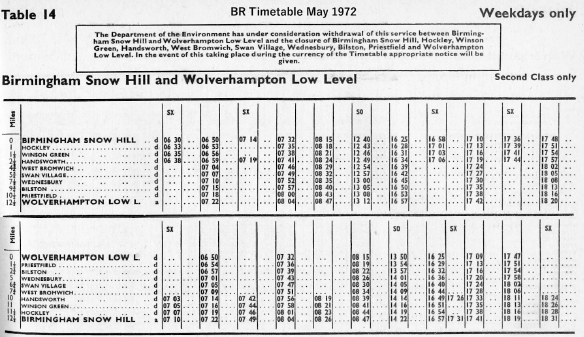
In 1969 the former GWR hotel, which had become the station’s administrative centre in the rebuilding of 1910, closed with staff transferred to a new Rail House on Broad Street in the centre of Birmingham. At 8am on 23 October 1969 Bill Edgington, an employee of the demolition contractors, started the demolition. Within three months the hotel and booking hall had been completely demolished and passengers were once again entering the station via Livery Street as they would have over a century earlier. The track through the main platforms and north bays (Snow Hill side) was also lifted around this time with the trackbed being infilled to platform level and the area turned into a car park and occasional film location.
BR and the Standard Gauge Steam Trust, now the Tyseley Steam Trust, organised the final working from Snow Hill on 4 March 1972 with LMR issuing special tickets for the final journey. The station was packed with enthusiasts and former employees for most of the day with many having travelled on some of the final local ‘all stations’ services prior to the final evening service. So many tickets had been sold that a BR Type 4 Class 47 loco and coaches was provided for the final fling. An article in the Steam Trust’s Journal recounted the atmosphere of the final day:.jpg)
‘As one gazed around, one realised what a great place of activity Snow Hill had been. The imagination returned to the mid-fifties when a “King” or “Castle” would sweep majestically into platform 7 on a London express, or even further back, to sounds of troops singing as they went off to war. Eventually the special arrived, reversing into number 1 platform. Driver Mostyn Wall eased diesel locomotive 1543 in readiness for departure and the sad moment had almost arrived. Red changed to green and the train departed into the night accompanied by a fusillade of detonators. The packed coaches echoed to the chatter and reminiscence of the enthusiast. Arriving at Stourbridge Junction, there was a short pause before heading back, to terminate in the slick modernity of Birmingham (New Street). As far as is known this was the only train ever to run from Snow Hill to New Street’.
The train could not run through to Wolverhampton Low Level as track rationalisation in the station rendered it impossible for the locomotive to run round its coaches.
In the early 1970s BR engineers had commissioned a structural report on the condition of the station and the whole structure was declared unsafe and in danger of collapse. Huge cracks were found in the walls with the mighty steel girders and rivets being badly eroded and weakened by rust. Below street level, in the parcels area, the foundation brickwork, alarmingly, bulged inwards. Demolition of the remaining portion of the station began on 4 October 1976 by L E Jones (Demolition) Ltd commencing from the north end of the station. The remaining glazing contained within the roof was first to be removed and a wrecking ball was brought in to demolish the steel girders. Amazingly, the steel work refused to budge and bulldozers had to be brought in to tear the steelwork from its foundations. Several sections of steelwork and the rivets which held it together were found to be seriously thin and very weak probably justifying the findings of the BR engineers and the demolition of the structure.
Prior to the demolition of Snow Hill the WMPTA had, on 31 October 1973, agreed to a long term introduction of a train service between Leamington Spa and Kidderminster using the trackbed of the former GWR mainline between Snow Hill and Handsworth Junction and south towards Moor Street. This would involve the reopening of Snow Hill Tunnel and construction of a new station on the site of the former. What became known as Phase One of the project involved the reopening of the Snow Hill tunnel and station construction, for trains to arrive from the south. Beginning in 1985 track would be laid to the northern end with all trains terminating and heading back in the same direction. Friday 2 October 1987 saw the first working into the new station hauled, fittingly, by BR Class 47 loco 47 484 Isambard Kingdom Brunel with the BR Chairman on board along with other dignitaries. They retired to The Grand Hotel for a celebratory luncheon, reminiscent of the early days of the railways. In 1988 the WMPTA lodged a Bill in Parliament for the reopening of the northern section of the line allowing for services to run through to Kidderminster and Stourbridge. The Department of Transport (DoT) would not approve the Bill until 1992 with, sadly, no money .jpg) forthcoming for construction. It was a grant offered by the European Regional Development Fund of £5,000,000 in mid 1992 that gave a lifeline to the project. The grant, made available via the DoT, came with one major clause: the contracts for construction must be signed by the end of the year! Construction of the northern section was estimated at £20,000,000 with BR and the WMPTA expected to foot the £15,000,000 shortfall. Construction began with a sod-cutting ceremony on 28 January 1993, and by the spring of 1994 the initial estimate of £20,000,000 for construction was realised to be short by at least £5,000,000. From 1 April 1995 BR was privatised with Railtrack (now Network Rail) assuming responsibility for the completion of the project. A game of brinksmanship ensued between Centro (the new name for the WMPTA) and Railtrack which nearly saw the project not completed. Railtrack wanted Centro to contribute more to the project as costs had reached £25,720,000 and the former wished to make no further contribution. Railtrack threatened to put the final phase of the contract on hold until Centro came up with an extra £1,860,000. Common sense prevailed and Centro stumped up the extra cash and Railtrack agreed to cover any extra costs that were incurred. forthcoming for construction. It was a grant offered by the European Regional Development Fund of £5,000,000 in mid 1992 that gave a lifeline to the project. The grant, made available via the DoT, came with one major clause: the contracts for construction must be signed by the end of the year! Construction of the northern section was estimated at £20,000,000 with BR and the WMPTA expected to foot the £15,000,000 shortfall. Construction began with a sod-cutting ceremony on 28 January 1993, and by the spring of 1994 the initial estimate of £20,000,000 for construction was realised to be short by at least £5,000,000. From 1 April 1995 BR was privatised with Railtrack (now Network Rail) assuming responsibility for the completion of the project. A game of brinksmanship ensued between Centro (the new name for the WMPTA) and Railtrack which nearly saw the project not completed. Railtrack wanted Centro to contribute more to the project as costs had reached £25,720,000 and the former wished to make no further contribution. Railtrack threatened to put the final phase of the contract on hold until Centro came up with an extra £1,860,000. Common sense prevailed and Centro stumped up the extra cash and Railtrack agreed to cover any extra costs that were incurred.
With the project completed a Gala day was organised for Sunday 24 September 1995 with Riddles Standard Class 4 Tank 2-6-4T No.80079, loaned from the Severn Valley Railway, operating a shuttle service between Snow Hill and Stourbridge Junction. Regular services began the following day with four trains per hour between Snow Hill and Stourbridge, two calling all stations and two semi-fasts.
The station itself comprised two wide island platforms each with a through line that narrowed at the north and the south end to double track. The main entrance is via Colmore Row, which is almost anonymous between the glass-clad office blocks standing on the site of the former GWR hotel. A modern functional ticket office is provided at street level with escalators and lifts to the platforms; not as grand as the GWR Snow Hill, but practical. Sitting above the platforms, on a concrete raft, is a City Council-owned car park giving the southern end of the station a rather dark and dingy feeling with diesel fumes unable to disperse easily.
Whilst construction was underway, on 20 June 1984 the WMPTA published a report entitled ‘Rapid transit for the West Midlands’. This plan was to link Snow Hill and Wolverhampton City .jpg) Centre using modern trams occupying the former main line trackbed from Snow Hill to a point north of Priestfield station where street running would begin along the Bilston Road. The Parliamentary Bill for the Midland Metro, as it was now known, received the Royal Assent on 16 November 1989. Contracts were signed for the construction and operation of the route on 3 August 1995, with a sod-cutting ceremony taking place at West Bromwich on 13 November 1995. Platform 4 at Snow Hill was taken out of use during September 1996 as it was earmarked to be the terminal platform of the new Midland Metro. Tram number seven departed on the inaugural journey from Snow Hill on 30 May 1999. Centre using modern trams occupying the former main line trackbed from Snow Hill to a point north of Priestfield station where street running would begin along the Bilston Road. The Parliamentary Bill for the Midland Metro, as it was now known, received the Royal Assent on 16 November 1989. Contracts were signed for the construction and operation of the route on 3 August 1995, with a sod-cutting ceremony taking place at West Bromwich on 13 November 1995. Platform 4 at Snow Hill was taken out of use during September 1996 as it was earmarked to be the terminal platform of the new Midland Metro. Tram number seven departed on the inaugural journey from Snow Hill on 30 May 1999.
Following privatisation of BR on 1 April 1995 several new companies started to operate services in the region, one being M40 Trains, latterly Chiltern Railways, who envisaged a new two-hourly London service from Snow Hill via Banbury and Oxford terminating at London Marylebone rather than Paddington. The service became half hourly in September 1998 using Clubman Class 168 DMUs, and this has since been augmented with locomotive hauled stock using brand new Class 68 locomotives and former BR Mk3 coaches, refurbished to a very high standard. Some services terminate at Snow Hill, from London, with others running out to Kidderminster. The station was now suffering from capacity problems, having only three heavy rail platforms, so extra siding space was provided on the wide bridge spanning Great Charles Street and the A38 allowing terminating Chiltern services to be shunted out of the station. Centro (now London Midland) services continued to expand with at least eight trains per hour plying their way between Worcester, Kidderminster and Stourbridge Junction to Stratford-upon-Avon, Shirley and Solihull.
Following completion of the Midland Metro extension, to Birmingham Grand Central (New Street), to extend the current tram network through the city centre to New Street platform 4 will revert to heavy rail use, thereby providing more station capacity. A new station entrance has been opened on Great Charles Street thus passengers no longer have to traverse the A38 subway and take the circuitous route to Colmore Row along with a Birmingham Snow Hill tram stop adjacent, although with no access, to the current station. The future is once again bright for a station that was wiped off the face of the earth in the 1970s.
Tickets from Michael Stewart & Brian Halford
|

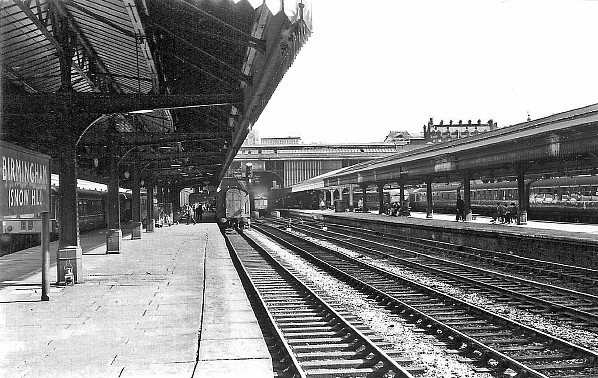
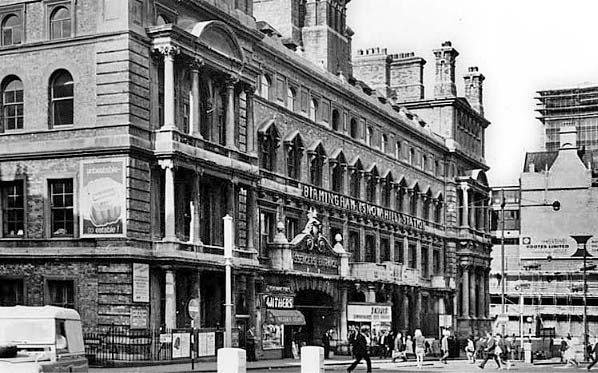 The exterior of Snow Hill in the mid 1960s, little changed in over 40 years.
The exterior of Snow Hill in the mid 1960s, little changed in over 40 years.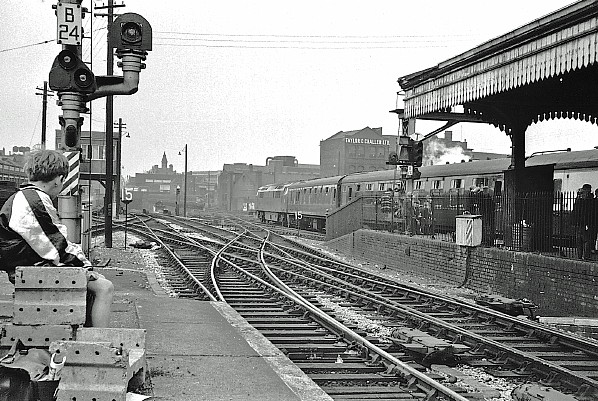
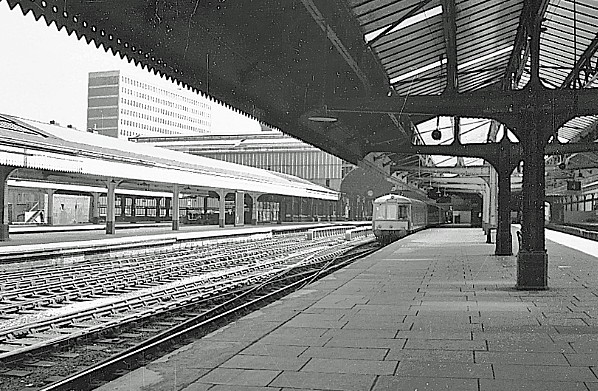
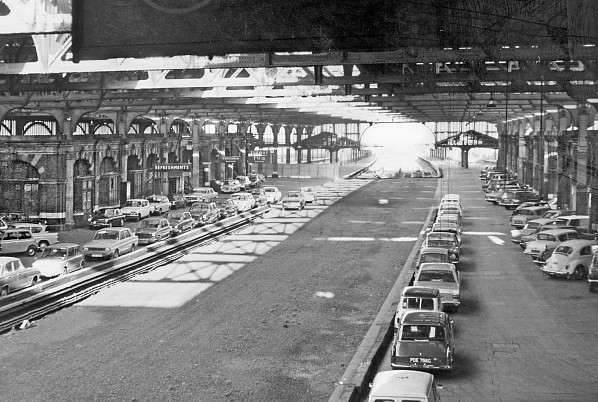
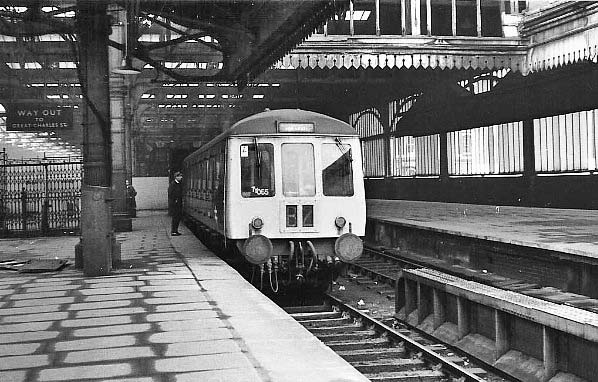
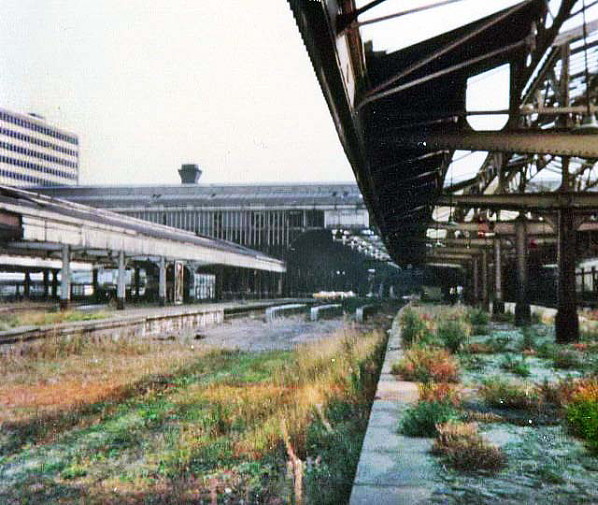
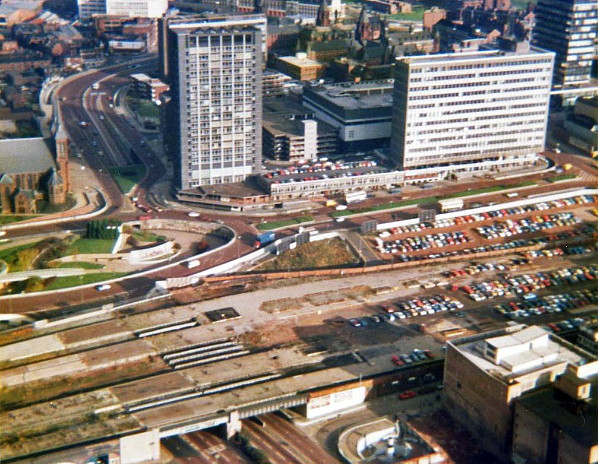 By the time this 1980 aerial shot was taken the station buildings had been cleared, the great length of the platforms, stretching out over the Ring Road, is clearly evident.
By the time this 1980 aerial shot was taken the station buildings had been cleared, the great length of the platforms, stretching out over the Ring Road, is clearly evident.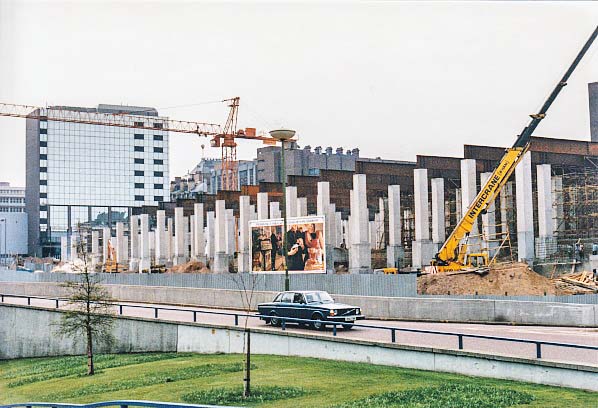
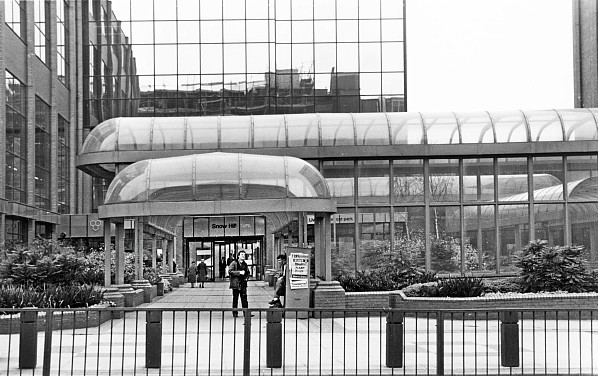
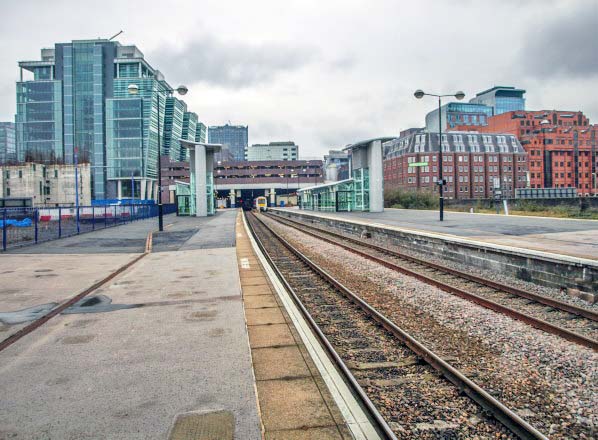
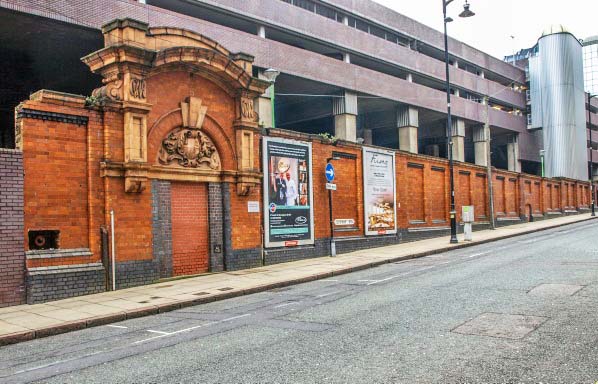 The most substantial remains of the 1871 rebuild is this section of wall in Livery Street complete with a rather splendid entrance adorned with the GWR crest. It is quite remarkable this has survived, not only, the subsequent rebuilding but the demolition of the station in the 1980s.
The most substantial remains of the 1871 rebuild is this section of wall in Livery Street complete with a rather splendid entrance adorned with the GWR crest. It is quite remarkable this has survived, not only, the subsequent rebuilding but the demolition of the station in the 1980s. and zoo until August. By the mid 1960s the LMR installed a connection with the former Midland Railway (MR) at St Andrews Junction allowing trains from Paddington to reach Birmingham New Street for the first time. Electrification of the New Street to Euston line was completed in early 1967 and a full electric service was inaugurated in March of that year. The LMR subsequently announced that Snow Hill would be closing to main line traffic from 4 March 1967 with all services to be concentrated on the New Street site; a reduction in the frequency of services to Paddington was to take place on the same day. So, from Monday 6 March 1967, only 74 trains would commence or end their journeys at Snow Hill compared to the former 181. To add to the reduction in workings through the station, from the same date all freight was diverted away from the station and 300 staff were also transferred to other positions within the LMR. A further blow for the station was seen on 2 March 1968 with the final local train departing, the 17.52 for Leamington Spa, through Snow Hill Tunnel and onto the North Warwickshire lines. All trains from the south were to terminate at Birmingham Moor Street from the 4 March. In May 1968 further rationalisation came with the closure of several of the stations along the northern part of the main line, and in August 1968 the main lines between Handsworth and Hockley were taken out of use with the remaining services moved to the relief lines. 5 May 1969 saw all stations from Snow Hill to Wolverhampton Low Level become unstaffed halts with the ‘Paytrain’ system implemented on which the train guard was expected to collect all fares. The single-car DMU, which plied between the two stations during the morning and evening rush hour, was surprisingly busy as the service was virtually unadvertised. Regular commuters gave themselves the nickname the ‘commuters club’.
and zoo until August. By the mid 1960s the LMR installed a connection with the former Midland Railway (MR) at St Andrews Junction allowing trains from Paddington to reach Birmingham New Street for the first time. Electrification of the New Street to Euston line was completed in early 1967 and a full electric service was inaugurated in March of that year. The LMR subsequently announced that Snow Hill would be closing to main line traffic from 4 March 1967 with all services to be concentrated on the New Street site; a reduction in the frequency of services to Paddington was to take place on the same day. So, from Monday 6 March 1967, only 74 trains would commence or end their journeys at Snow Hill compared to the former 181. To add to the reduction in workings through the station, from the same date all freight was diverted away from the station and 300 staff were also transferred to other positions within the LMR. A further blow for the station was seen on 2 March 1968 with the final local train departing, the 17.52 for Leamington Spa, through Snow Hill Tunnel and onto the North Warwickshire lines. All trains from the south were to terminate at Birmingham Moor Street from the 4 March. In May 1968 further rationalisation came with the closure of several of the stations along the northern part of the main line, and in August 1968 the main lines between Handsworth and Hockley were taken out of use with the remaining services moved to the relief lines. 5 May 1969 saw all stations from Snow Hill to Wolverhampton Low Level become unstaffed halts with the ‘Paytrain’ system implemented on which the train guard was expected to collect all fares. The single-car DMU, which plied between the two stations during the morning and evening rush hour, was surprisingly busy as the service was virtually unadvertised. Regular commuters gave themselves the nickname the ‘commuters club’. .jpg) Snow Hill and the branch to Langley Green but allowing the closure of the southern section from Snow Hill through to Moor Street. With this the four-track section between Handsworth and Hockley could no longer be justified, so in August 1968 it was announced that the main lines would be closed and all remaining traffic concentrated on the relief lines. The introduction of the May timetable in 1969 saw all intermediate stations between Wolverhampton Low Level and Birmingham Snow Hill become unstaffed halts, making Snow Hill the largest unstaffed halt in the world; Nottingham Victoria had briefly held this inglorious record in its final two months in 1967. Monday 4 March 1968 saw the withdrawal of services south of Snow Hill and the tunnel and lines through to Moor Street taken out of use; coupled with this the services from Stourbridge Junction were diverted into New Street, although a two-hourly shuttle was introduced between Snow Hill and Langley Green to connect with it. On the same day the service frequency was drastically reduced, this not requiring any permission from the TUCC or
Snow Hill and the branch to Langley Green but allowing the closure of the southern section from Snow Hill through to Moor Street. With this the four-track section between Handsworth and Hockley could no longer be justified, so in August 1968 it was announced that the main lines would be closed and all remaining traffic concentrated on the relief lines. The introduction of the May timetable in 1969 saw all intermediate stations between Wolverhampton Low Level and Birmingham Snow Hill become unstaffed halts, making Snow Hill the largest unstaffed halt in the world; Nottingham Victoria had briefly held this inglorious record in its final two months in 1967. Monday 4 March 1968 saw the withdrawal of services south of Snow Hill and the tunnel and lines through to Moor Street taken out of use; coupled with this the services from Stourbridge Junction were diverted into New Street, although a two-hourly shuttle was introduced between Snow Hill and Langley Green to connect with it. On the same day the service frequency was drastically reduced, this not requiring any permission from the TUCC or  the Minister of Transport. The station now had just three morning and three evening services in each direction, with a lunchtime Saturday- only service to cater for shoppers on the route to Wolverhampton. This was supplemented by the Langley Green shuttle which had four down, Snow Hill to Langley Green, and 5 up services per day. By the end of 1970 the station had a very run-down atmosphere with vandalism prevalent, and passenger numbers had dwindled to less than a tenth of what they had been just four years previously. The newly-formed West Midlands Public Transport Authority (WMPTA) recognised the importance of the route although, as it did not become responsible for local rail services until 1972, it could not react to the next move that BR made. Closure notices were posted by BR on 31 March 1971 with the final date for objections to be received as 19 May 1971. The TUCC received 199 objections in total, and on 25 May they, along with representatives from BR and WMPTE (the Executive body of the WMPTA), inspected the route and all the stations travelling from Snow Hill by train to Wolverhampton; ironically they returned by bus! A Public Hearing was held at the Rainbow Suite in Birmingham on 14 July 1971 for objections to be voiced and for the fate of the line to be decided. One objection from D J Yew Tree of West Bromwich stated, ‘I use the train from West Bromwich to Snow Hill to get to work…… I shall suffer hardship because it will mean me having to get three buses, thus more than doubling my journey time each day’. Despite the best efforts of the TUCC and the folk who objected to the closure it was granted, by the Minister, on 24 January 1972 with BR (LMR) swiftly announcing that the final trains would run on 4 March 1972.
the Minister of Transport. The station now had just three morning and three evening services in each direction, with a lunchtime Saturday- only service to cater for shoppers on the route to Wolverhampton. This was supplemented by the Langley Green shuttle which had four down, Snow Hill to Langley Green, and 5 up services per day. By the end of 1970 the station had a very run-down atmosphere with vandalism prevalent, and passenger numbers had dwindled to less than a tenth of what they had been just four years previously. The newly-formed West Midlands Public Transport Authority (WMPTA) recognised the importance of the route although, as it did not become responsible for local rail services until 1972, it could not react to the next move that BR made. Closure notices were posted by BR on 31 March 1971 with the final date for objections to be received as 19 May 1971. The TUCC received 199 objections in total, and on 25 May they, along with representatives from BR and WMPTE (the Executive body of the WMPTA), inspected the route and all the stations travelling from Snow Hill by train to Wolverhampton; ironically they returned by bus! A Public Hearing was held at the Rainbow Suite in Birmingham on 14 July 1971 for objections to be voiced and for the fate of the line to be decided. One objection from D J Yew Tree of West Bromwich stated, ‘I use the train from West Bromwich to Snow Hill to get to work…… I shall suffer hardship because it will mean me having to get three buses, thus more than doubling my journey time each day’. Despite the best efforts of the TUCC and the folk who objected to the closure it was granted, by the Minister, on 24 January 1972 with BR (LMR) swiftly announcing that the final trains would run on 4 March 1972. 
.jpg)
.jpg) forthcoming for construction. It was a grant offered by the European Regional Development Fund of £5,000,000 in mid 1992 that gave a lifeline to the project. The grant, made available via the DoT, came with one major clause: the contracts for construction must be signed by the end of the year! Construction of the northern section was estimated at £20,000,000 with BR and the WMPTA expected to foot the £15,000,000 shortfall. Construction began with a sod-cutting ceremony on 28 January 1993, and by the spring of 1994 the initial estimate of £20,000,000 for construction was realised to be short by at least £5,000,000. From 1 April 1995 BR was privatised with Railtrack (now Network Rail) assuming responsibility for the completion of the project. A game of brinksmanship ensued between Centro (the new name for the WMPTA) and Railtrack which nearly saw the project not completed. Railtrack wanted Centro to contribute more to the project as costs had reached £25,720,000 and the former wished to make no further contribution. Railtrack threatened to put the final phase of the contract on hold until Centro came up with an extra £1,860,000. Common sense prevailed and Centro stumped up the extra cash and Railtrack agreed to cover any extra costs that were incurred.
forthcoming for construction. It was a grant offered by the European Regional Development Fund of £5,000,000 in mid 1992 that gave a lifeline to the project. The grant, made available via the DoT, came with one major clause: the contracts for construction must be signed by the end of the year! Construction of the northern section was estimated at £20,000,000 with BR and the WMPTA expected to foot the £15,000,000 shortfall. Construction began with a sod-cutting ceremony on 28 January 1993, and by the spring of 1994 the initial estimate of £20,000,000 for construction was realised to be short by at least £5,000,000. From 1 April 1995 BR was privatised with Railtrack (now Network Rail) assuming responsibility for the completion of the project. A game of brinksmanship ensued between Centro (the new name for the WMPTA) and Railtrack which nearly saw the project not completed. Railtrack wanted Centro to contribute more to the project as costs had reached £25,720,000 and the former wished to make no further contribution. Railtrack threatened to put the final phase of the contract on hold until Centro came up with an extra £1,860,000. Common sense prevailed and Centro stumped up the extra cash and Railtrack agreed to cover any extra costs that were incurred. .jpg) Centre using modern trams occupying the former main line trackbed from Snow Hill to a point north of Priestfield station where street running would begin along the Bilston Road. The Parliamentary Bill for the Midland Metro, as it was now known, received the Royal Assent on 16 November 1989. Contracts were signed for the construction and operation of the route on 3 August 1995, with a sod-cutting ceremony taking place at West Bromwich on 13 November 1995. Platform 4 at Snow Hill was taken out of use during September 1996 as it was earmarked to be the terminal platform of the new Midland Metro. Tram number seven departed on the inaugural journey from Snow Hill on 30 May 1999.
Centre using modern trams occupying the former main line trackbed from Snow Hill to a point north of Priestfield station where street running would begin along the Bilston Road. The Parliamentary Bill for the Midland Metro, as it was now known, received the Royal Assent on 16 November 1989. Contracts were signed for the construction and operation of the route on 3 August 1995, with a sod-cutting ceremony taking place at West Bromwich on 13 November 1995. Platform 4 at Snow Hill was taken out of use during September 1996 as it was earmarked to be the terminal platform of the new Midland Metro. Tram number seven departed on the inaugural journey from Snow Hill on 30 May 1999. 
 Home Page
Home Page